8th Field Hospital Unit History
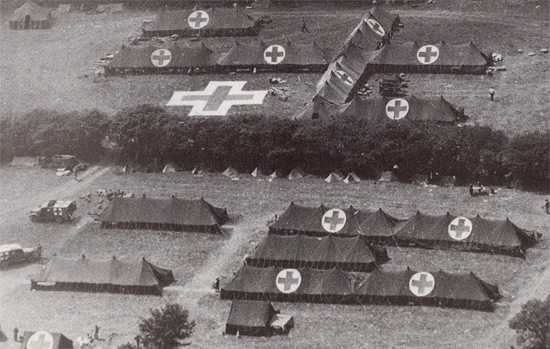
Aerial view of an unidentified Field Hospital set up in the Cotentin Peninsula, France. Geneva Convention ground marker and air recognition markers are highly conspicuous.
Introduction & Activation:
The 8th Field Hospital was activated on 25 January 1943 at Camp Butner, near Raleigh, North Carolina (Division Camp with an acreage of 40,344 and a troop capacity of 2,403 Officers & 41,700 EM –ed) from a cadre of the 25th Field Hospital which moved from Tilton General Hospital, Fort Dix, Wrightstown, New Jersey (named after James Tilton (1745-1822), US Army Surgeon General 1813-1815 –ed), on 17 January in order to establish the new unit.
The Commanding Officer was Major Kilday, and Captain Andrew M. Gehret was appointed Executive Officer and Plans & Training Officer. The unit immediately embarked upon an intensive training program of classes and physical conditioning. Captain A. Gehret was promoted to Major on 3 May 1943, and when Major Kilday was transferred to a General Hospital because of ill health on 16 July he took over the unit.
Preparation for Overseas Movement – United Kingdom:
The 8th Field Hospital was now preparing to move overseas and the majority of Officers were assigned to the unit. The Nurses however, did not join until the unit reached the Port of Embarkation. The Hospital sailed with its full allocation of 20 Officers, 18 Nurses and 190 Enlisted Men.
It disembarked at Swansea, South Wales and moved to Hermitage, just north of Newbury which held a 750-bed Station Hospital. The Officers and men were housed in Nissen huts and all ate in the Enlisted Men’s mess, with the Officers sitting down to a separate meal a half hour after the men. However they only stayed there for nine days after which the next unit was ready to move in. The 8th Field Hospital moved south to another Station Hospital at Ferndown, Eastmoor, near Ringwood. Again they were housed in permanent buildings but here a separate Officers’ and Nurses’ mess was established. The wards had to be thoroughly cleaned and the grounds prepared. They were not to stay there long because six weeks later, on 7 November, the 8th Field Hospital again moved, this time to another 750-bed Station Hospital site just outside of the village of Everleigh, on the northern edges of Salisbury Plain. All personnel were quartered in Nissen huts and after a week the Officers were established with a separate mess from the Enlisted Men, but consolidated with the 570th Motor Ambulance Company. After another week they were allowed to move into the wards because this Hospital was not operational. In all these locations the role of the 8th Fld Hosp was to prepare the hospital plant for the units that were to operate them later.
The next move was much further afield because the unit was transferred south-west to Truro, Cornwall to set up a tented Hospital. The advance party of 5 Officers and 60 Enlisted Men left on 8 December 1943 while the rest of the unit left by rail two days later. The site, where they were to operate a functioning Hospital, was located a half mile south of the town of Truro, Cornwall, at map coordinates 143/6724. It was on the site of a cricket field but it turned out to be a sea of mud when the unit arrived. The wards and sections of the Hospital were set up in ward tents and the entire organization was billeted in tents; the Officers four to a pyramidal tent and with a mess established in a ward tent adjacent to the kitchen tent. Initially all Enlisted Men were quartered in ward tents because of a shortage of standard pyramidal tents. They had to act and work as engineers and install roads, lay steel matting, wire the hospital for lighting and build a shower unit under tentage for the entire unit.
The role of the Hospital was to act as a Station Hospital for troops concentrated in the area, with a capacity of 400 beds. South of Truro lay the port of Falmouth and there were a number of ‘hards’ which were to be used to load landing ships and craft. The 29th US Infantry Division was gathering and training in Cornwall and they were initially intended to land on D-Day as one of the immediate back-up units to the assault divisions to land on Omaha and Utah beaches that very day. The troops were housed in camps across Devon and Cornwall and later would move to temporary marshaling areas set out in sausage-shaped tented camps strung out along the country lanes surrounding Truro. The 8th Field Hospital received its first patients on 15 December 1943.
In January 1944 these hards were used for the pre-invasion maneuvers and the personnel were required to set up First-Aid Stations in the marshaling areas and hards but the amount of cases coming in to the Hospital, 80% of which were medical in nature, meant they had to be recalled and their place taken by other medical units. Many of the admissions were upper respiratory tract infections but there were also cases of recurrent malaria from troops who had previously served in the Mediterranean Theater. The dispensary was very busy and required two full-time Medical Officers; it was housed in half of the admissions tent. Surgery was located in a ward tent with a work room and autoclave in the rear and the operating theater in the front half, enclosed in sheets. The workload became increasingly high and to counter this a similar installation was established at Probus, a village 12 miles away, during the last week of January. It had 100 beds and was opened in just fourteen days.
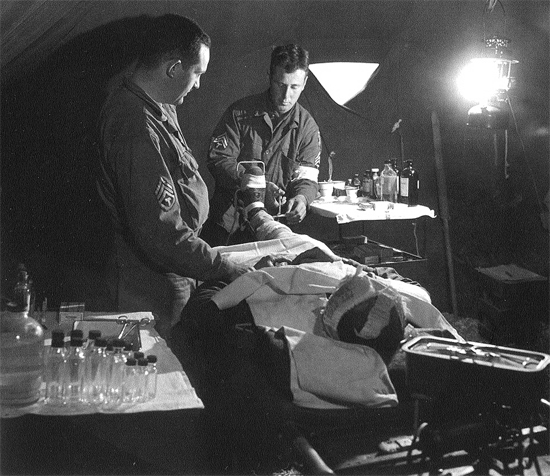
Inside view of an Operating Room in the field …
Casualties from both units requiring more extensive hospitalization or treatment that was not available at the 8th Field Hospital were sent to fixed hospital installations, the nearest being the 315th Station Hospital at Tavistock on the Cornwall/Devon border. Patients were transported there by Hospital Trains or by Ambulance convoys. On 21 April 1944, the 314th Station Hospital was established at Polwhele, just north of Truro in tented accommodation, and all the patients from the 8th Fld Hosp were transferred the short distance across the town to that new plant. The 8th then ceased to operate at Truro, after having admitted 2,515 patients; none of them died whilst in the care of the Field Hospital.
On 20 March ‘Detachment A’ had been ordered to move to Dartmouth to serve as an emergency Hospital, offering the same treatment as the Truro location, but it did not stay there for long. On 20 April it moved to Crownhill Barracks, on the northern edges of the City of Plymouth where it was joined by the unit’s Headquarters. The other two elements of the unit were sent to other locations at the same time. ‘Detachment B’ went to Fort Tregantle, East Cornwall and ‘Detachment C’ was sent to the port of Falmouth in West Cornwall. The troops of the 29th Infantry Division were to depart from a number of embarkation areas and these locations were set up with the aim to support the troops being gathered in marshaling camps in the locality prior to departure. The Headquarters of the 29th Infantry Division was at Fort Tregantle from 22 May through 2 June 1944 when it boarded LST 414 and LST 511 to prepare for the trip across the channel to Normandy. Fort Tregantle was a Victorian squat, granite fort built to guard the western approaches to the key naval port of Plymouth. The troops grouped in camps nearby were to depart from embarkation hards on the edges of the Tamar River and in western Plymouth. Likewise, there were many troops gathering around Truro and they were to depart from hards either side of the Fal estuary near Falmouth. Plymouth also had a number of hards and again its barracks were used as a center for the grouping of Allied units. In all of these locations the actual demands made upon the three Hospital Platoons of the 8th Field Hospital were light.
Preparation for Crossing Over to the Continent:
The unit was alerted for movement and all the elements packed their equipment but this was subsequently revoked and they all unpacked and reopened in their existing locations. However four days after the invasion took place ‘Detachments A and B’ were ordered to join ‘Detachment C’ at Penryn with the expectation that they would sail to France within the week. Surgical Teams were recalled, arriving on 13 June, and two new Doctors were received to meet the Tables of Organization. Male personnel were housed in individual pup tents and female personnel in pyramidal tents. The Enlisted Men continued the packing and labeling, and adorned the ward tents with white circles and red crosses. Meanwhile the Nurses and Officers went on 10-mile hikes, with packs, in the sunny June weather and along roads bordered by high grassy banks. They stayed at Penryn until 20 June 1944; that day they packed again and the personnel of C Company, 93d Medical Gas Treatment Battalion provided their last hot meal at the location. The personnel of the 8th Field Hospital spent the day sitting in the sun or playing baseball waiting for the trucks to arrive and eventually at supper word was passed around to say they would board a troop train at 2200 hours. They effectively did and arrived at Seaton Barracks, Crownhill, Plymouth at 0130 the following morning. ‘Detachment C’ had spent six weeks stationed at the small Hospital located just downhill from the Barracks. This time they had nothing to do but wait for their final movement to France. While there, they were briefed that one Detachment was to operate outside Montebourg, whilst the other two were to move to Granville, a small port down on the western side of the Cotentin Peninsula; the problem with this plan was that Granville had not yet been captured by the Allies. Generally while casualties expected on the day of the first landings did not take place, the enlargement of the Beachhead was much slower than expected and this caused a build-up of Hospital units on the ‘near shore’ particularly of fixed units.
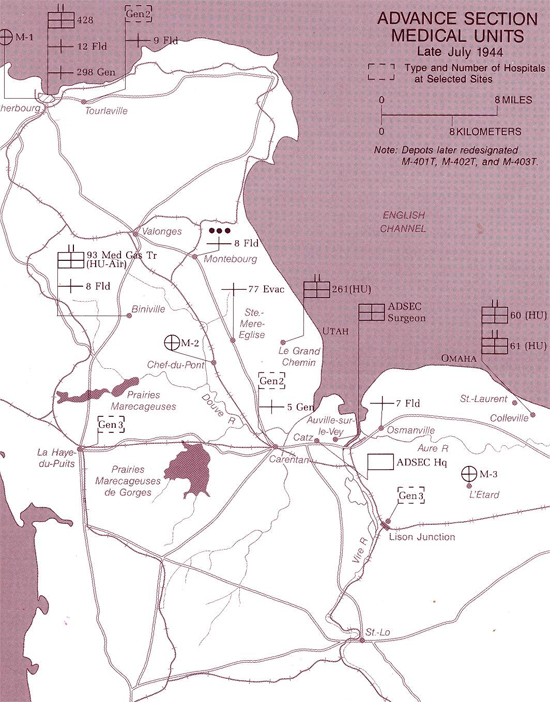
July 1944, France. Map showing ADSEC Medical units set up in the Cotentin Peninsula, Normandy.
France
Eventually on 26 June 1944, the 8th Fld Hosp left at 1100 hours by truck for the journey to the hard. This involved negotiating the curving roads down to the harbor area, sent on their way with the ‘good luck’ calls of the British inhabitants and a ‘Stars and Stripes’ flying from a small house on the way. Clad in life belts the personnel were loaded into LCVPs and ferried out to the ‘HMS Empire Gauntlet’, an American ship crewed by the British (ex-Cape Comorin, C1-S-AY1 hulk built by Consolidated Steel, Wilmington, California, USA, and delivered to Britain Jan 44, along with 12 other similar LSI (L) landing craft). They climbed aboard up rope netting and settled in; boat drill was held and the guns fired to show the protection the ship afforded. The crew were immensely proud of the fact they had landed invasion troops on the beaches on D-Day and the quarters and food provided were good. Twenty-four hours later they arrived off Utah Beach and became part of the hustle and bustle with myriad types of ships and craft anchored or moving in and, depositing fresh units and supplies, then picking up casualties etc. The LCAs from the ‘Empire Gauntlet’ joined in and shuttled in to drop the 8th Field Hospital at a small pier built by US Engineers on Sugar Red Beach. They stepped onto the beach and urged on by the beach control units moved onto a road and given vague directions as to the next destination. The CO found trucks to carry the Nurses and they moved a short way inland to a Control Point where they were directed to a large, empty field. The women broke out their K-Rations for supper and soon were joined by the first of the groups of male personnel who had hiked five dusty miles with full field equipment. A few were pitching pup tents when trucks started pouring into the field and the unit was moved to the location of the 91st Evacuation Hospital to whom it was attached for rations and quarters. They were then trucked through Ste-Mère-Eglise and up a small lane to a meadow. The 91st Evac had just moved but there were still a few tents and latrines available for the personnel of the 8th.
ADSEC medical units located in the Cotentin Peninsula
12th Field Hospital (Cherbourg 30 June 1944)
9th Field Hospital (Tourlaville 12 July 1944)
77th Evacuation Hospital (Sainte-Mère-Eglise 15 July 1944)
93d Medical Gas Treatment Battalion (Biniville 17 July 1944)
298th General Hospital (Cherbourg 17 July 1944)
8th Field Hospital (Biniville 20 July 1944)
The next day, 28 June, the Hospital moved again to the new location of the 91st Evacuation Hospital near Pont L’Abbé. This was three miles from the front and on territory only captured two days earlier. They were not operational yet and so the staff of the 8th Field was able to peruse their setup and ask questions of this veteran unit. Surrounded by the debris of war, the 8th got used to their new surroundings and their proximity to the fighting was brought home when German shellfire landed in surrounding fields that night, necessitating a quick move to foxholes. Over the next few days the unit’s equipment and vehicles were located and ‘Detachment B’ departed to set up a 100-bed Hospital on the main highway to Ste-Mère-Eglise, two miles south of Montebourg. The aim was to receive and treat patients from the ComZ Advance Section (ADSEC) and to set up and help administer a medical transit camp.
Meanwhile the other elements of the unit enjoyed five further days of respite before they received instructions to move to Cherbourg and set up a 200-bed hospital. The order was received at 1400 hours and they were to be ready to receive their patients at 2000 hrs that same night. The patients were to be flown to England from a nearby advanced airfield. The attached Ambulance Company bivouacked across the road were approached to provide transport for the two Detachments. Two hours after receiving the order they were ready to go and the convoy set off for Cherbourg. They made good progress until they reached the outskirts of the town but no one was there to show them where to go. After a wait of an hour and C-Rations for supper they again set off and ended the journey in a field in Quergueville (west of Cherbourg). However they learnt that the airfield to be used would not be ready for ten to fifteen days. The next day the crestfallen outfit had another blow – two of the three attached Surgical Teams were sent out on DS to front-line Hospitals. The Nurses were returned to ‘Detachment B’ near Montebourg. Meanwhile the two Detachments set about treating the small number of cases presented to them, including victims of road accidents, landmines and even the medical ailments of French civilians. On 13 July, ‘Detachments A and C’ returned to Montebourg and pitched their camp in a site vacated by an antiaircraft artillery unit and just across the road from an abandoned quarry where the 8th Field Hospital had established its portable shower unit. ‘Detachments A and C’ were in the same field but separate from each other while ‘Detachment B’ was located less than a mile away. A few days later the 93d Medical Gas Treatment Battalion arrived and camped nearby. Acquaintances made in Cornwall were renewed. Under an agreement with the First United States Army signed on 17 July the Advance Section (ADSEC –ed) would open holding units in the field for air evacuation. On 19 July, the 93d Medical Gas Treatment Battalion was ordered to move to Biniville (about 15 miles south of Cherbourg) followed by ‘Detachment C’. Together they were to establish an air evacuation holding facility for patients being evacuated from the nearby airfield. The tented camp which spread over several hedgerow-lined fields opened on 20 July.
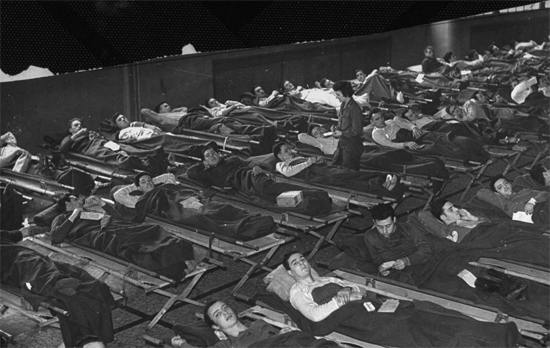
France, 1945. Patients on folding cots in ward 1, 8th Field Hospital
‘Detachment B’ continued in its role as a station hospital and ‘Detachment A’ remained in staging and occupied itself with games of baseball and in exploring the surrounding countryside. The 203d General Hospital then arrived and ward tents were pitched for the Officers and Nurses of that unit; they too joined in the relaxing regime.
Meanwhile the 93d Medical Gas Treatment Battalion, with ‘Detachment C’, 8th Field Hospital attached, were learning how to set up and operate an air holding unit, a task which neither had previous experience of. The Hospital was quickly established from 27 double-ward tents, attached end-to-end. It could house 750 patients and ‘Detachment C’ could provide hospital care to 120 of the most seriously ill or wounded patients who needed more care than the holding unit could provide. The Hospital included a functioning OR, X-ray, Laboratory and Pharmacy section. The next day the first patients were received. Gradually the two units built up their learning and overcame the obstacles to their efficient operation with roads being built by the engineers, signs erected and latrines and kitchens improved. At the time 900 patients was seen as a major achievement but later this was far surpassed. The organization held them for treatment when required, and, when they were ready to travel, they were loaded on aircraft at the nearby airstrip used exclusively for evacuation.
Fresh casualties were received from Army Hospitals and from Battalion Aid Stations, especially after the attack on St.-Lô. ‘Operation Cobra’, was announced by Group after Group of the Eighth and Ninth Air Forces flying overhead in their diamond formations to drop bombs on the German frontlines. This was on the morning of 26 July 1944, and the constant demand on the Hospital required the drafting in of an extra Surgical Team to help the unit. The pressure on the Hospital continued to grow and so on 2 August ‘Detachment A’ left Montebourg and set up additional wards for holding patients at Biniville. On 11 August, the Headquarters of the 8th Field Hospital moved to Biniville. Gradually the demands on the Hospital began to abate as the frontlines got further away, the Allied formations having broken out of the Normandy Bridgehead started to pursue the Germans across Northern France towards Paris. On 18 August 1944, the rumors circulating took concrete form when the 93d Medical Gas Treatment Battalion left Biniville to set up another air holding location and ‘Detachments A and C’ were left to run the operation at ALG A-24 at Biniville (operational 17 Jul – 21 Aug 44). By now very experienced in this type of operation they managed this, with admission rates dropping, until on 24 August the Hospital closed.
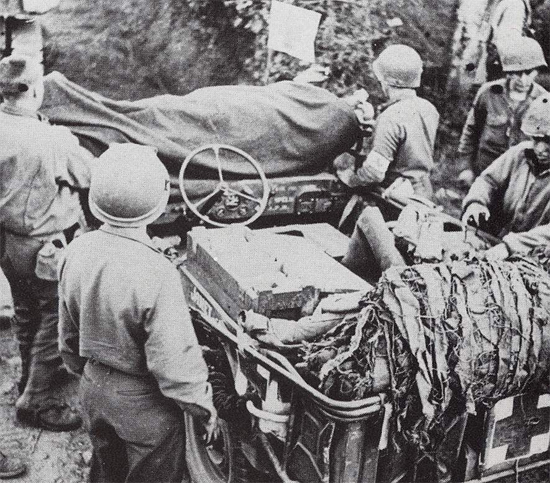
Summer of 1944, somewhere in Normandy, France. Medical personnel are preparing a casualty for evacuation by a 1/4-ton truck (aka jeep).
For the period from 24 August to 2 September the entire Hospital went into a period of rest and having struck the ward tents and packed equipment the unit enjoyed a few warm days swimming on the beaches and playing athletics. This had to end and as they were preparing to move on it became evident that there was a lack of trucks and gasoline to accomplish this as the trucks and drivers had meanwhile been loaned to another Field Hospital. Eventually the personnel of the 8th found another truck pool but there were no drivers so enough to make the move were found among some Officers and Enlisted Men of the Hospital. ‘Detachment C’ went to Melun on 3 September where they were to establish a station hospital for the 3d Replacement Depot. The work was similar to that carried out in Truro and Montebourg, with a preponderance of medical cases.
On 4 September, ‘Detachment B’ went to Le Bourget (Advanced Landing Ground built around the current French airfield in the northern outskirts of Paris) and teamed up once more with the 93d Medical Gas Treatment Battalion to set up the hospital for the air holding unit and its role was the air evacuation of casualties to the UK from ALG A-54 (Le Bourget, operational 29 Aug 44 – 1 May 46). Upon arrival they realized that the field was a sea of mud, much worse than what they experienced in Truro and the situation and the volume of work taxed the Detachment, so shortly afterwards, ‘Detachment A’ joined them. The work was very different from that at Biniville for a great deal of surgery was required and all the Surgical Teams were therefore recalled and employed flat-out. Meanwhile ‘Detachment C’ at Melun (where Airfield A-55 was located, operational since 15 September) was having a short-lived period of serenity, in contrast to the hive of activity at Le Bourget. On 21 September the 93d Medical Gas Treatment Battalion again moved forward and ‘Detachment C’ moved to Le Bourget to join the rest of its parent unit which operated the evacuation center on its own.
The activity was constant with the movement of patients all day and most of the night when the weather allowed. Whereas at Biniville a thousand patients was unheard of, here it was commonplace. Personnel struggled to cope with this high volume, and the mud which got worse as the unit operated there in tented accommodation. In the initial phases of the operation the unit suffered from inadequate lighting at a time when it was trying to operate 24 hours a day. Sometimes it was necessary to bring ambulances up to the admissions tent to use the headlights to work by and the kerosene lamps used in England became vital on each ward. The kitchens were pushed to their full capacity.
Operating in a tented facility near the runways in the mud lasted for 15 days and then the unit was informed it was to move into permanent buildings, for the first time, since it had started operating as a Hospital in the ETO. A large school house was taken over for Hospital and quarters for the Enlisted Men. The Officers were to be housed in a building erected by the Germans. On 3 October the building was cleaned and ready for occupancy and on 6 October the Hospital was prepared to receive patients in its new location. However the need for labor had not abated and it was required in the wards, in the kitchens, for cleaning purposes and for admission and evacuation. The 426th Motor Ambulance Company was attached to the 8th Field as was the 706th Medical Sanitary Company. The work of the colored soldiers was excellent and they performed a variety of duties such as litter bearers and guards both in the Hospital and on the Airfield. Eventually the 8th Field Hospital was aided by 300 French civilians and by a large number of German Prisoners of War in the daily operation of the facility. The routine consisted in handling over 1,000 patients a day, mostly incoming casualties from First and Third United States Armies, and outgoing evacuees from the Paris group of General Hospitals.
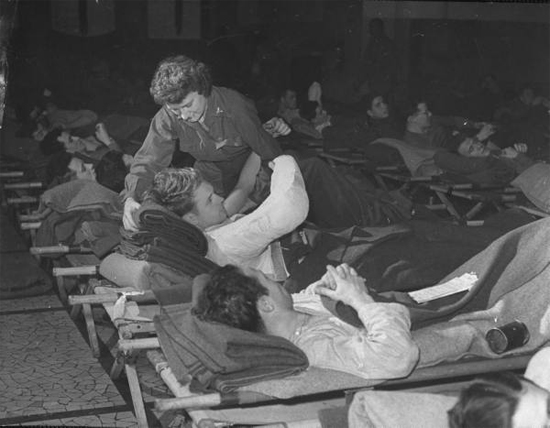
Nurse at the 8th Field Hospital, helping a patient awaiting air evacuation to the United Kingdom or to the Zone of Interior.
Initially the patients were received at the medical installations of the Paris-based Hospital group (Paris had meanwhile grown as the hub of the continental medical evacuation system), triaged there and those chosen for movement were taken to the holding point. Some of the biggest challenges were in moving large numbers of patients from Paris in a steady flow of ambulances while at the same time avoiding the accumulation of large numbers of patients at either end of the journey. The steady flow also served to make admission, disposition, and evacuation, including the administrative arrangements, easier and quicker. The Hospital also had to have good communications with the Airfield as the availability of space on aircraft returning to the UK had to be managed with patients readied and dispatched as required.
The capacity of the Hospital plant under this new regime was 600-800 more than the authorized organizational strength of the 8th Field Hospital but soon the numbers of patients being held exceeded even that and the Enlisted personnel of the unit were moved to the top floor of the Hospital which added more than 250 beds to its current capacity. Beyond this a further 400 places were provided in winterized tents erected over concrete bases. The throughput continued to grow and the peak was 1,600 medical cases evacuated in a day and with 600 held and treated on the wards this meant that the 8th Field Hospital cared for 2,400 that same day. The normal load was between 1,200 and 1,400 on days when the weather was suitable for evacuation.
Subsequently the casualties were flown from the forward locations direct to the holding units where they were triaged. Seriously ill patients were being received in this route and X-ray and surgical elements of the Hospital were constantly stretched. Dressings and casts were changed for those that did not require surgery. The Paris-based Hospitals were also contributing large numbers of patients putting great demands on the unit’s personnel. This situation continued throughout the peak of activity caused by the German counter-attack in the Ardennes (16 December 1944) and until 21 March 1945 when the 180th Station Hospital moved in to replace the 8th Field Hospital. By that time a very large number of patients had been evacuated to the United Kingdom. In addition, the 8th had provided a Station Hospital facility including sick call and laboratory facilities for the static troops in the area and Army Air Forces personnel using and stationed at A-54 (Le Bourget).
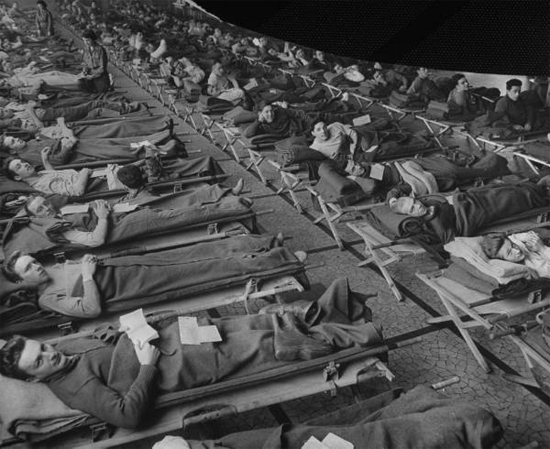
France, 1945, another view of patients at the 8th Field Hospital, awaiting air evacuation.
Much of the equipment was left behind to aid the 180th Station Hospital and although they were afraid of the prospect of a trip in “40 and 8”s personnel traveled in reasonably comfortable French railway cars, departing Paris on 22 March 1945 and arriving at Maastricht, Holland, two days later. There they waited in bivouac until 12 April 1945 and they had the first rest since leaving England. The equipment was surveyed, repaired and replaced but many of the personnel were hospitalized for various reasons.
On to Germany:
Then the order came to move to Coesfeld, Germany, by motor convoy, arriving the same day, on 12 April. Part of the unit was to stay at a large German Hospital outside of town while another Detachment went to a different installation at Maria Veen, in North Rhine-Westphalia. They were to take over the care of a thousand Recovered Allied Military Personnel (RAMPs). These people had been captured and for many years had been used as cheap labor by the Germans.
At Maria Veen there were 500; many were seriously ill with advanced pulmonary tuberculosis while others were wounded or injured and all were almost starving. Their treatment had changed their behavior; they distrusted everyone including the doctors, hoarded scraps of food and had little idea of personal cleanliness and sanitation and did not use latrines and washing facilities provided. The first task was to clean up the filthy buildings and make them habitable. All patients were shaved and bathed and all pulmonary cases were X-rayed and then segregated if they showed any signs of the disease. All were fed well and the food was consumed voraciously. Guards had to be placed on the garbage heaps as the patients were afraid they would not get the next meal. With the passage of time and change of regime their morale improved and so did their habits.
This care caused a great demand on the personnel of the 8th Field Hospital and although there was an active program of movie shows every other night, good messing, and decent living quarters, other factors meant the time in Germany was draining. The size of the task and the difficulty in communicating with the patients meant the staff was exhausted.
Eventually all patients were moved to the one Hospital at Coesfeld, although this took several days. There eleven units of ward tents were set up with each unit containing three tents capable of housing up to sixty patients. Many of the patients at Coesfeld had proven not to be affected with TB.
From 12 April to 18 June 1945, there were a total of 1,384 admissions of which 517 were rehabilitated and returned to duty. During their stay at Coesfeld 90 patients died and 70 were transferred to other medical facilities for additional care, which left 647 patients, of whom 464 suffered from TBC. 210 operations took place, many of them major.
Back to France:

Aerial view of the Calas Staging Area, near Marseille, Southern France, taken in 1945. The place was the main staging area for troops and/or replacements being redeployed or transferred to the Pacific Theater.
On 19 June 1945, the British RAMC took over responsibility for medical care of RAMPs in the Münster area and the following day the 8th Field Hospital climbed into boxcars for a five and a half day journey south to the area of Marseille, Southern France. Having arrived at 0100hrs on 26 June they were immediately ordered to unload 16 boxcars of equipment which took six hours. The equipment was taken to Arles where the 8th FH was to establish a 500-bed Hospital to care for the troops being staged there. Then four days later orders were received sending Headquarters and one of the Hospitalization units to Biarritz to furnish medical care to the Army University Center #2 being established there. This was part of the projects created by the Delta Base Section (ComZ established the Assembly Area Command on 9 April 1945, to operate the camps and staging areas designated to receive units marked for redeployment and to house and entertain them during processing). The largest was the one operating near the Port of Marseille, France. Eventually, the Delta Base Section would control 5 General Hospitals and 3 Station Hospitals between Biarritz and Nice, to serve the transients, representing a capacity of 13,000 beds, of which almost 9,000 were constantly occupied. The Delta Base Section personnel-staging area was rapidly developed to provide the necessary facilities to accommodate 200,000 US troops at one time in three large areas of Southern France: Calas – Saint-Victoret – Arles. Its Headquarters were located in Marseille and the organization employed approximately 70,000 men and women to supply, maintain, and care for military personnel being prepared for overseas movement – redeployment (POM-RED).
Campaign Credits – 8th Field Hospital
Normandy
Northern France
Central Europe
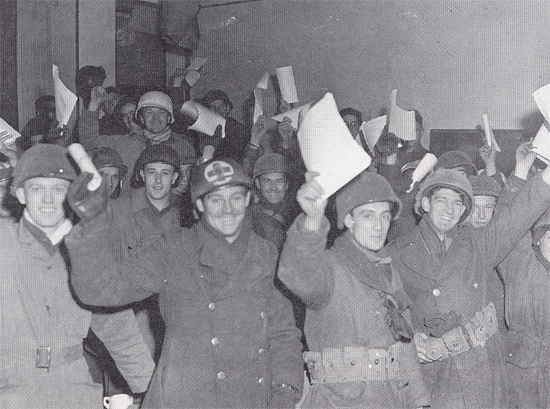
V-E Day… the War in Europe is over – the next move is – going home.
Above Unit History was generously provided by Tony Honeyman, a British Historian who has previously helped the MRC Staff with interesting documents and data relating to WW2 US Army Hospitals. Any extra data as well as a Personnel Roster would be most welcome. Thank you.
